
* As discussed earlier, the Boeing 707 was the basis for a number of military special-mission aircraft, most significantly the "E-3 Sentry" airborne early warning and control aircraft, the "E-6 Mercury" strategic nuclear flying command post, and the "E-8 Joint-STARS" battlefield surveillance platform -- these three described in this chapter.
* In 1963, the US Air Force issued a requirement for a replacement of its piston-engined EC-121 Warning Star, an airborne early warning (AEW) aircraft based on the Lockheed Constellation propliner. The new "Airborne Warning & Control System (AWACS)" would involve a more modern aircraft and updated mission avionics. Preliminary contracts were issued to Boeing, Douglas, and Lockheed for the aircraft itself; in 1967, another program was begun to develop the radar system, with contracts awarded to Westinghouse Electric and Hughes.
Boeing initially thought of designing an entirely new aircraft for the AWACS competition, but decided it would be better to base it on the existing Boeing 707. Douglas similarly wanted to base their AWACS on the comparable Douglas DC-8 jetliner, while Lockheed ended up dropping out.
Boeing won the contract in 1970, which specified construction of two initial "EC-137D" machines, modified from 707-320B jetliners taken off the production line, retaining the passenger windows. Initial flight of the first EC-137D was on 9 February 1972. In that same year, the Westinghouse AN/APY-1 radar was selected as the winner of the radar competition. In 1973, Boeing won a full development contract, with four pre-production "E-3A" to be manufactured, two of them modified from the EC-137Ds. The first production machine was rolled out in October 1976, with the type going into service in 1977 with the 552nd Airborne Warning & Control Wing at Tinker AFB in Oklahoma, which would become the primary AWACS base. A total of 24 baseline or "Core" E-3As was built, including three pre-production machines brought up to production standard.

* Externally, the E-3A was clearly a Boeing 707-320, with the distinctive 707 HF antenna on the tailfin, differing in having a radar rotodome -- mounted on twin pylons in an inverted-vee configuration above the rear fuselage -- plus an HF antenna trailing on each wingtip, military colors, no passenger windows, single-point ground refueling, a mid-air refueling socket, and a bail-out chute. There was a single toilet in the rear, as well as a galley and crew rest area.
Early in development, there had been consideration of fitting eight General Electric TF34 high-bypass turbofans in pairs. The decision was made, presumably for cost, to stay with the 707-320's JT3D / TF33 low-bypass turbofans -- though they were somewhat dated by that time and reduced the aircraft's endurance, with tanker support required for long missions. Each TF33 engine had an electrical generator, the four generators providing a total megawatt of power to drive the aircraft's electronic systems.
Of course, the rotodome provided a major distinction from the stock 707-320B. Initial concepts featured the rotodome on top of a forward-swept tailfin, but that would have meant major revision of the airframe. The rotodome was 9.1 meters (30 feet) in diameter and 1.8 meters (6 feet) thick; it was slightly tilted forward to reduce drag. It featured doors and cold plates to keep the electronics cool. The antenna itself was a planar slotted array, with 53 slots, generating a wide flat beam. There was an AN/APX-103 identification friend or foe (IFF) antenna to the back of the radar antenna, facing in the opposite direction.

The rotodome turned at a rate of once every ten seconds in use -- once every four minutes when idled, just to prevent the rotodome drive from seizing up. Aircraft hydraulic systems were uprated to drive the rotodome. Originally, there were nine operator "Situation Display Consoles (SDC)", and two spare "Auxiliary Display Units (ADU)", being controlled by an IBM CC-1 computer that processed the radar inputs. The radar operated in five different modes:
Range of the radar was effectively line of sight -- hundreds of kilometers at altitude, depending on terrain, or even more with the BTHP mode. In service, an E-3 could track all air activity over the battlespace, and direct friendly air assets appropriately.
BACK_TO_TOP* Having obtained 24 E-3As, the USAF later converted them to "E-3B" machines, with updated systems -- see below on updates -- and then obtained nine more "E-3C" machines to a further improved standard. That gave 33 E-3s for the USAF, plus another "JE-3C" machine on USAF books, but retained by Boeing for trials. The last USAF E-3 was delivered in 1984.
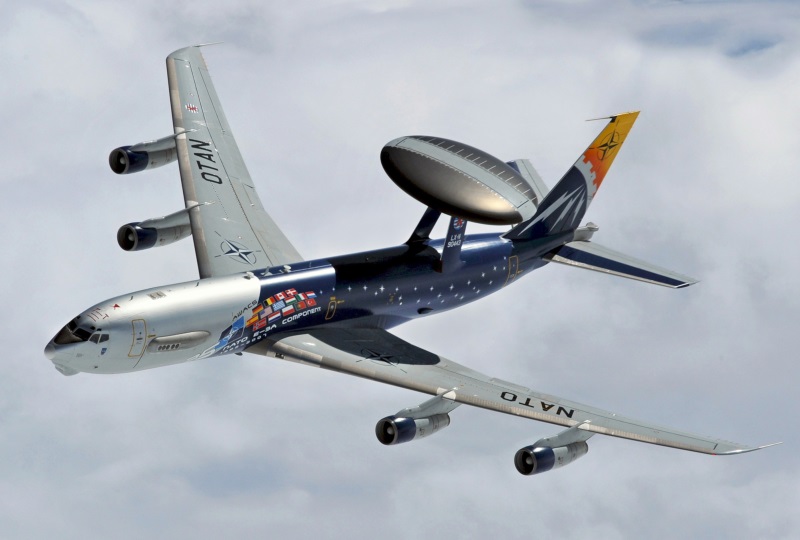
There were also foreign sales:
That gave a total of 34 + 18 + 5 + 7 + 4 == 68 E-3s produced. Iran tried to buy ten E-3s, but the order was canceled because of the Iranian Revolution. Japan wanted to buy E-3s, but since the 707 was out of production, obtained four Boeing 767 airliners with E-3 kit under the designation of "E-767".
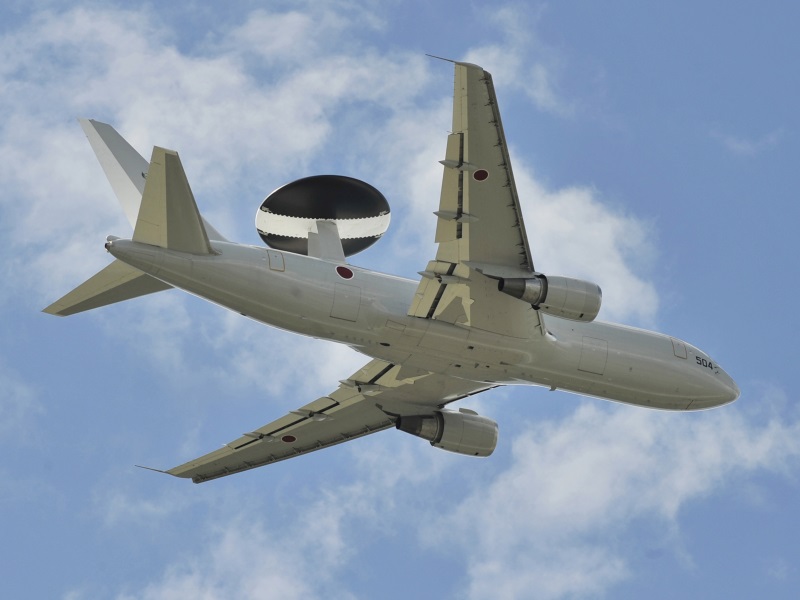
* The E-3 evolved considerably over the decades. The original 24 "Core" E-3s were, as mentioned, upgraded to E-3B standard under the "Block 20" program, which featured an improved AN/APY-2 radar, with a basic maritime surveillance mode -- as well as CC-2 processor, plus addition of five more SDUs, for a total of 14 operator stations. The first upgrade was redelivered in 1984. The nine "Standard" E-3s, the E-3Cs, were the same, but added "Have Quick" secure voice radios.
A "Block 30/35" upgrade program was begun in 1997, the initial focus being on replacement of high-maintenance subsystems. Other elements included:
The last USAF Block 30/35 update was redelivered in 2001. Even as the Block 30/35 update was underway, work on an improved radar system was underway, under the "Radar System Improvement Program (RSIP)", with hardware and software changes including:
The last USAF RSIP update was redelivered in 2005. It was followed in turn by the "Block 40/45" update, which focused on replacing the CC-2E processor and operator stations with an "open-architecture" processor running the Linux operating system, and Windows-based full-color operator stations that coupled radar inputs to datalink data. Another major update was a new, much more capable AN/UPX-40 IFF interrogation system. The upgrade also provided new a new "Link-16" datalink -- a superset of JTIDS -- and updated ESM.
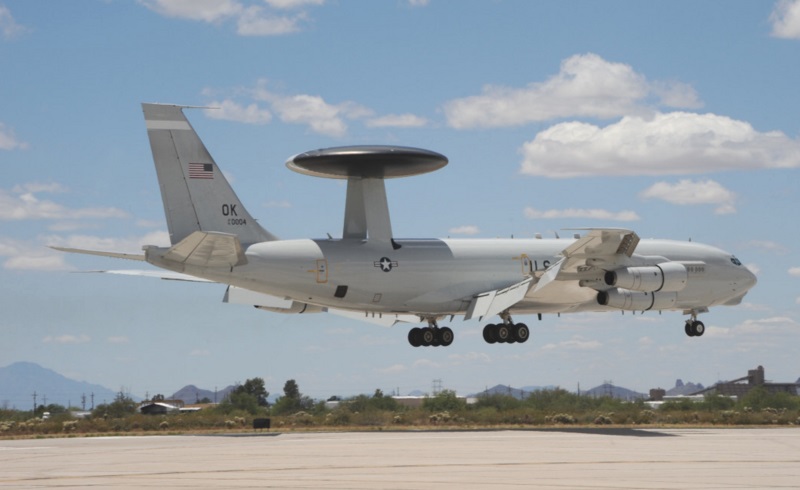
The updated machines, redesignated "E-3G", provided a huge jump in capability; the E-3's computing systems were contemporary for the 1980s, but a mainframe computer of that era was far less powerful than a middling modern smartphone. One USAF officer said the upgrade was like moving from "an Atari to an Xbox" game system. First service deployment to an operational theatre was in 2015; the upgrade proved more troublesome than expected -- complex systems are like that -- and the upgrade program is not expected to be done until 2024.
Roughly in parallel with the Block 40/45 upgrade, from 2009 the USAF and NATO worked on a cockpit update under the "Diminishing Manufacturing Sources Replacement of Avionics for Global Operation & Navigation (DRAGON)", program, featuring a "glass cockpit" with five color displays, a new AN/APS-133 color weather radar, new datalinks, a "Terrain Avoidance & Warning System (TAWS) -- and the "Automatic Dependent Surveillance / Broadcast Out (ADS-B Out)" system, which broadcast the location, direction, and speed of the aircraft to prevent midair collisions. Oddly, an "ADS-B In" capability wasn't added; it appears that, for whatever reasons, it wasn't needed.
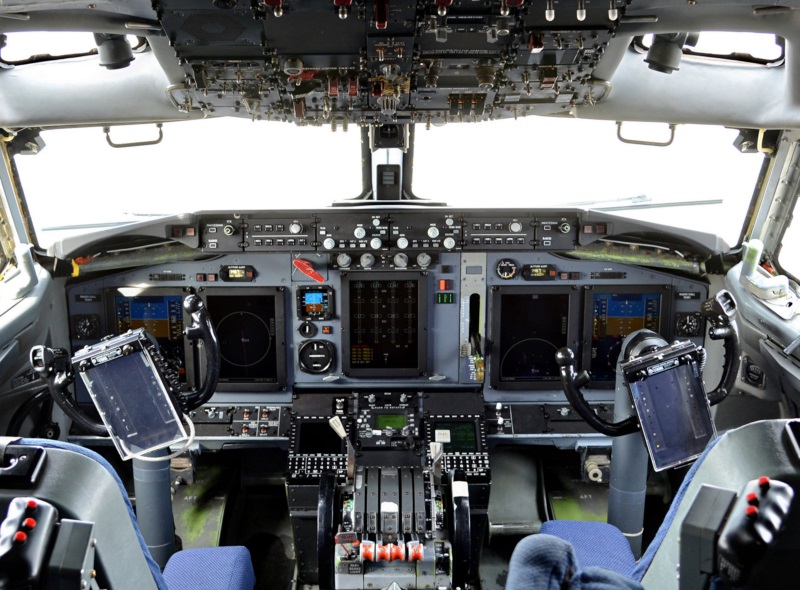
* Upgrades of export E-3s went along roughly in parallel with those of USAF machines, but only roughly; trying to nail down the upgrade history for each user is an exercise in frustration. RSIP was actually a joint USAF-NATO program, and all the NATO E-3s were updated from 1997 to 2000, before any of the USAF machines were. It seems all other E-3 users upgraded to RSIP -- including the Japanese E-767 machines, which were delivered with Block 30/35 systems.
In addition, NATO didn't get involved with the Block 40/45 update program, conducting their own "NATO Mid-Term (NMT)" modernization, with a new central processor, display consoles, communications, IFF, and navigation systems. The first machine was redelivered in late 2006, with the last of 17 aircraft updated by the end of 2008. NATO was the only client of the NMT upgrade. From 2006, the NATO machines were fitted with the AN/AAQ-24 large aircraft infrared countermeasures (LAIRCM) self-protection system. It doesn't appear that the E-3s of any other nations have been fitted with LAIRCM.
BACK_TO_TOP* The E-3 has been a foundation stone of US battle operations since the Gulf War in 1992. During Operation Desert Storm, E-3s flew 379 missions and logged over 5,000 hours of time on station. In addition to providing the brass with timely intelligence on adversary operations, E-3 controllers assisted in 38 of the 41 air-to-air kills performed during the conflict. It served in other conflicts from that time, with NATO E-3As maintaining patrols in the Russo-Ukraine war in 2022:23, maintaining air surveillance over Ukraine from the Black Sea or NATO airspace.
At last notice, 14 of the 18 NATO E-3As were still in service -- one was written off after an accident in 1996, and three others retired. The NATO fleet is expected to stay in service to 2035, with a Final Lifetime Extension Program (FLEP) begun in 2019 to bring their technology up to a more modern standard.

The RAF fleet was out of service in 2022, being replaced by the Boeing E-7 Wedgetail, an advanced AWACS based on the Boeing 737. There is little mention of how much longer the French and Saudi E-3s, as well as Japan's E-767s, will remain in service. The USAF envisions their E-3s remaining in service into the 2030s, but planning to replace it with the E-7. Of the 35 obtained by the Air Force, 16 were available at last count, two having been lost in crashes, the rest having been retired.
There has been a suspicion that AWACS doesn't make sense any more. One problem with the E-3 is that it advertises its presence with its powerful radar, making it a prime target for long-range radar-seeking anti-aircraft missiles -- "AWACS killers", as they are known. Although the AWACS can shut down its radar and take evasive action, that still neutralizes it.
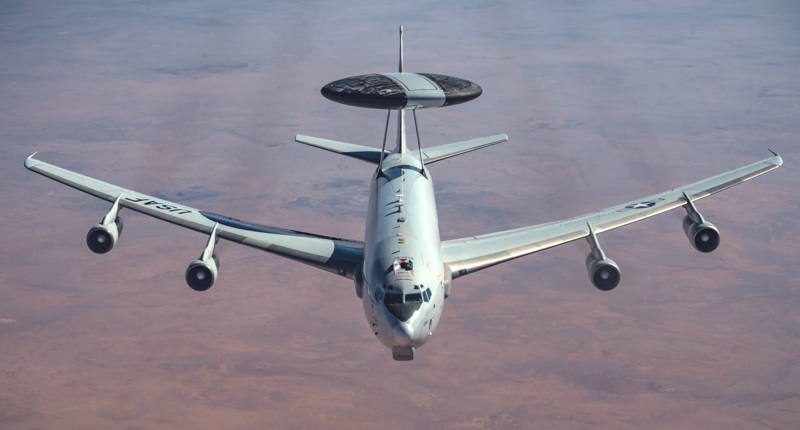
The most obvious option is to fly a constellation of small radar satellites in low Earth orbit, though it is possible that high-flying stealthy drones -- with "low probability of intercept" radar -- could be used as well. However, the Air Force appears to be moving forward on the E-7 at this time.
BACK_TO_TOP* The E-6 Mercury was obtained to replace the Navy's Lockheed EC-130Q machines, which conducted the "Take Charge And Move Out (TACAMO)" mission, providing communications with the US Navy's ballistic missile submarines. All work was performed by Boeing, with initial flight on 19 February 1987. The first "E-6A Hermes" went into service with the US Navy in 1989, and the last of the 16 built in 1992. They operated out of Tinker AFB in Oklahoma, The name was changed from "Hermes" to "Mercury" in 1991; why the name was changed is unclear -- but it is possible that "Hermes" sounded too much like "herpes".
The E-6A was based on the 707-320B, though with CFM56 turbofans, as mentioned. The E-6A carried a crew of about 12, roughly evenly split between flight crew and mission crew. A senior officer of the mission crew, the "aircraft commander", gave the orders on a flight. The E-6 carried long deployable VLF (Very Low Frequency) radio antennas capable of communicating with submerged ballistic-missile ("boomer") submarines, VLF having some ability to penetrate into the water.
The VLF system featured a "Long Trailing Wire Antenna (LTWA)" with a length of 8,535 meters (28,000 feet) and a "Short Trailing Wire Antenna (STWA)" with a length of 1,525 meters (5,000 feet). The LTWA was deployed from the extreme tail of the aircraft, while the STWA was deployed from a hatch under the rear fuselage. Once on station, the E-6A performed a banking orbit, with the effect of trailing the antennas in a near-vertical orientation. Bandwidth being proportional to wavelength, the VLF system's bandwidth was very low, only able to send a brief code once a second.
There was a video camera, with a floodlight, under the extreme tail to keep an eye on the LTWA; presumably, there was also a camera in the hatch from which the STWA was deployed. In addition, the E-6A had a litter of small antennas on the fuselage, the classic 707 HF antenna on the tailfin, and a forward-facing HF antenna mounted in an underwing pod near each wingtip.
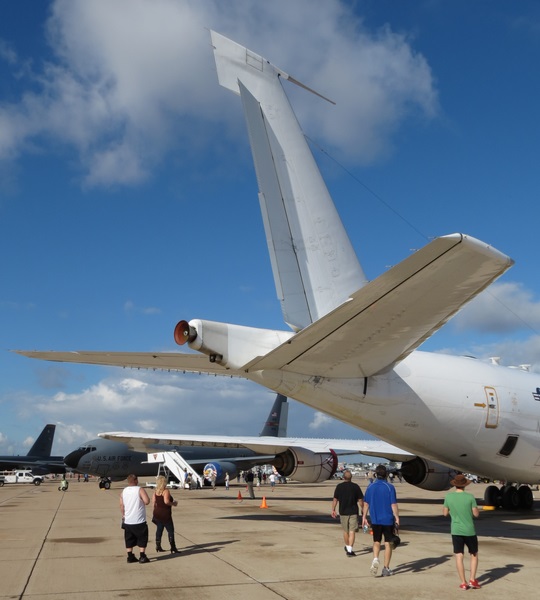
From 1992, the E-6A fleet was given an "Avionics Block Upgrade (ABU)", which included:
This upgrade was followed by an "Orbit Improvement System (OIS)", which featured updates to the throttle system and computer systems to permit more efficient station orbiting. From 1995, the E-6As were updated to "E-6B" configuration through the "Command Post Modification (CPM)" to support the USAF's "Looking Glass" mission, "mirroring" the ground control system for land-based intercontinental ballistic missiles -- that mission having been previously performed by EC-135C aircraft, and discussed in more detail later.
The CPM ported over gear from the EC-135Cs, including the "Airborne Launch Control System (ALCS)" plus communications gear, with a new SATCOM communications system installed. Crew increased to 22. The E-6B went into service in 1998, with the last CPM machine delivered in 2003.
Boeing began work on a digital class cockpit upgrade for the E-6B in 2002, based on that developed for the Boeing 737 jetliner. The new cockpit featured six flat-panel displays and provided compliance with Global Air Traffic Management (GATM). Communications gear was also improved. First redelivery was in 2006.
A "Block 1" upgrade was initiated in 2004, to replace the VLF transmitter system, install new operator workstations, and provide other system updates, including a secure communications network capability. The upgrade also included a new auxiliary power unit (APU) turbine to boost power and cooling capabilities. The first Block I E-6B was returned to service in 2009.
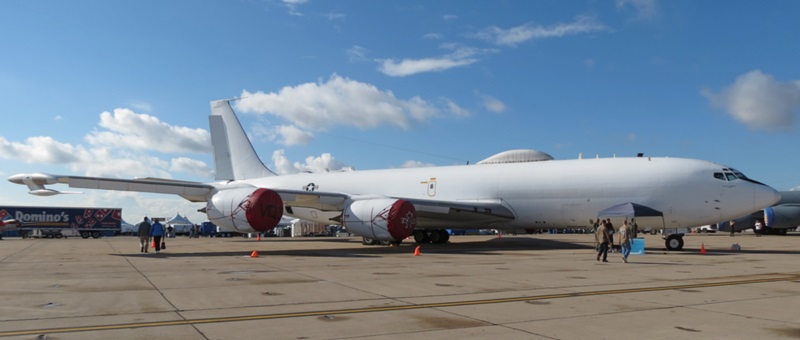
Other update efforts have followed, primarily to provide further enhanced communications capabilities, as well as to perform a service-life extension program (SLEP). The SLEP program was set up to stretch E-6B airframe life to 2040, with the updated aircraft returned to service in 2010:2017. In 2018, the USAF began an effort to replace the Airborne Launch Control System, with the new system to be fielded by 2024.
However, the future of the E-6B is ambiguous. In 2021, the Navy announced that the TACAMO mission would revert to the C-130, in the form of the "EC-130J", to be fielded before the end of the decade. That would leave the E-6B with the Looking Glass mission, but the Air Force appears to be still working to figure out where to go from there.
BACK_TO_TOP* In the 1970s, US military interest in advanced battlefield surveillance systems led to development work towards an advanced synthetic-aperture radar (SAR) radar ground-mapping sensor codenamed PAVE MOVER by the US Defense Advanced Research Projects Agency (DARPA) and the US Air Force (USAF). The US Army was also considering a battlefield surveillance system based on the Sikorsky H-60 helicopter, designated the "Stand-Off Target Acquisition System (SOTAS)". Costs of SOTAS soared, and the Army was forced to abandon the project. Shortly afterward, in 1982, the Army and the Air Force merged their programs, and spent the next two years combining their requirements. The result was the E-8C "Joint Surveillance & Target Acquisition Radar System (Joint-STARS)".
Joint-STARS was intended to provide an all-weather battlefield surveillance platform that could detect, locate, identify, classify, track, and target enemy assets on the battlefield, and pass this information on to US command and strike elements on land, sea, or in the air using datalinks. The Army was to obtain data from Joint-STARS through truck-mounted AN/TSQ-178 "Ground Station Modules (GSM)", which would be attached to headquarters organizations to give ground commanders a window onto the battlefield.
Grumman's Melbourne Systems Division in Florida won the contract in 1985, and began development of two "E-8A" prototype Joint-STARS platforms, based on used Boeing 707-320C jetliners obtained from commercial operators. Initial flight of the first E-8A was in 1988, with both E-8As available for operational test during the first Gulf War in 1991, where they proved remarkably useful, even though they were not production-specification machines. In the meantime, a contract was awarded for a single production prototype E-8C in 1990, which would fly in March 1994, followed by award in 1993 of a "low rate initial production (LRIP)" contract for five E-8Cs, with deliveries beginning in 1995.
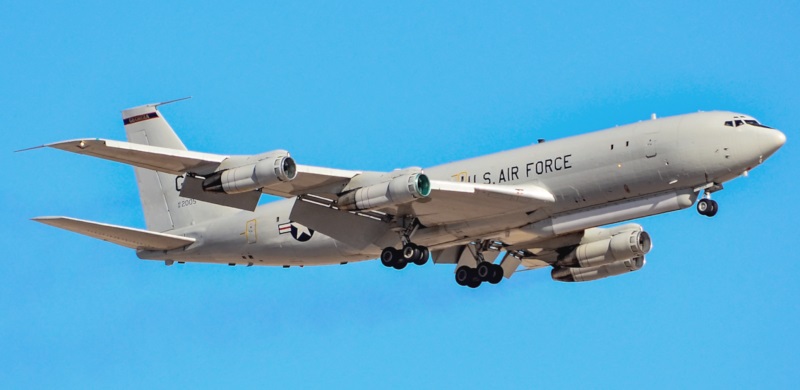
Since the 707 was no longer in production, all Joint-STARS platforms were rebuilt from used machines, but the Boeing 707 was built rugged, the airframes had plenty of life left in them, and the "used" market for the 707 was good. Other aircraft platforms -- including new-build 707s with modern CFM turbofan engines, Boeing 757 or 767 airliners, or the McDonnell-Douglas MD-11 airliner -- were considered, but the cost of new aircraft was simply too high, and the hope was that basing Joint-STARS on used aircraft would reduce delays in reaching operational service. New-build 707s had been seriously considered and in fact were to be the basis of an "E-8B" Joint-STARS, but Boeing finally shut down 707 production completely. Some observers have suggested that the Pentagon made a foolish bargain in staying with used aircraft -- producing analyses that show on a full "life-cycle" basis, the costs were not really lower, but the capability was.
* Outside of the extensive fit of electronic systems, few changes were made in the 707-320C aircraft itself. One obvious addition was a boom-refueling receptacle behind the cockpit, not a common item on commercial aircraft. The cockpit layout remained much as it was in commercial service, with no update to modern glass cockpit standards. Most significantly, the aircraft retained its original Pratt & Whitney JT3D / TF33 turbofan engines.
Of course, the electronics fit was something the original designers of the 707-300 could have barely imagined. The interior was fitted with two rows of display and control consoles, while the fuselage prominently displayed a 7.3-meter (24-foot) long "canoe" fairing mounted behind the nosewheel, which accommodated the antenna for the Norden-built AN/APY-3 phased-array multimode radar.

The antenna mechanically tilted from side to side for elevation scanning, but azimuth scanning was performed electronically through phase-interference techniques. The radar system provided four primary operating modes:
All reconnaissance data was stored on board and could be displayed on operator workstations or dumped to a fast laser printer. Data collected over a period of time could be displayed in a "movie" format to allow a battle commander to observe the evolution of the combat situation.
Communications to external stations were through a "Surveillance & Control Data Link (SCDL / Skittle)". The data was picked up by the truck-mounted GSMs, which had two display consoles and a laser printer, and GSM operators could access Joint-STARS data without intervention from the operators on board the aircraft. The GSMs included a telescoping antenna that could be jacked up to a height of 30 meters (100 feet), and towed a generator to provide power. The GSMs also included a GPS receiver to allow them to pinpoint their own locations using the GPS navigation satellite constellation. There was no real limit to the number of GSMs that could link up to Joint-STARS, though obviously communications bandwidth became a bottleneck as the numbers of GSMs increased.
Joint-STARS was also fitted with the JTIDS datalink, used to relay targeting and other data to strike aircraft, as well as to communicate with the E-3 Sentry or other AWACS platforms. In addition, the two E-8A Joint-STARS prototypes were fitted with a small fairing on the belly just behind the wings and in front of the little SCDL antenna. This fairing housed the antenna for the "Flight Test Data Link (FTDL / Fiddle)" and, as its name implies, was intended solely for development flight test purposes.
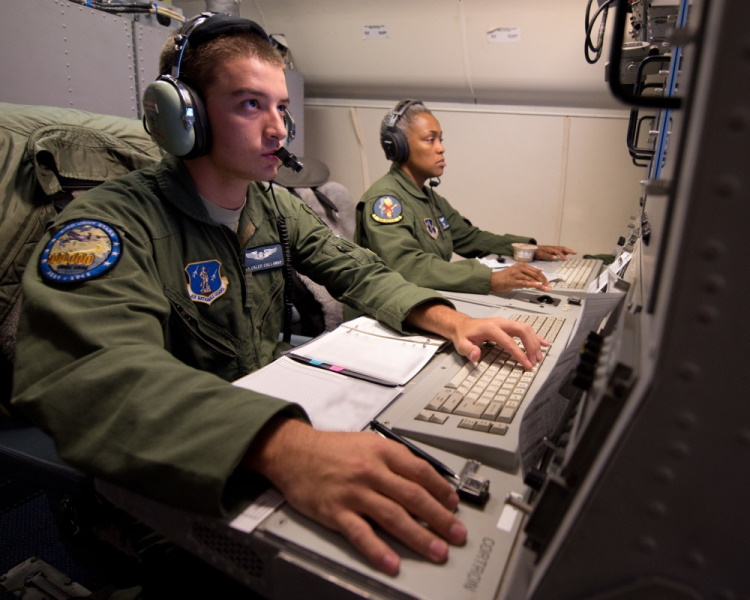
* The E-8A prototypes were fitted with a variable number of operator consoles, depending on the progress of development activity, and also included at least one test console. The production E-8C included 17 operator consoles, plus a "defensive systems" console. The defensive systems included warning sensors but no active countermeasures, and certainly no defensive armament.
The standard mission crew count was 21, and included both Air Force and Army personnel. Seating was provided for takeoff and landing, and there were six bunks and a rest area. Up to 34 crew could be taken on long-endurance missions, with the aircraft kept in flight with mid-air refueling.
BACK_TO_TOP* The two E-8As were sent to Riyadh, Saudi Arabia, to participate in Operation DESERT STORM, the offensive to drive the Iraqis out of Kuwait. The two aircraft arrived on the night of 11:12 January 1991, and were performing the first of 49 combat sorties on 14 January, two days before the start of the air war. They were supported by six GSMs, and protected in the air by fighter "barrier" combat air patrols.
Although this deployment was in principle simply an operational evaluation and the aircraft were only fitted with about ten operator consoles, the two Joint-STARS aircraft proved valuable combat assets, targeting Iraqi combat elements, particularly during their hasty and disastrous retreat from Kuwait. Joint-STARS sensor imagery mapped out the movements of Iraqi vehicles on the "Death Highway" and pinpointed them for attack. One senior USAF officer grimly commented on the Joint-STARS service in DESERT STORM: "Moving targets did not stay moving for long."
The formal planned Joint-STARS operational evaluation did not actually begin until 1995, with stateside tests leading to deployment of one of the E-8As and the first E-8C to Germany to support Operation JOINT ENDEAVOR, the US peacekeeping mission to Bosnia. The second production E-8C was also deployed later. Joint-STARS flew missions over the Balkans from December 1995 through March 1996. This exercise was to lead to full-scale production, but results were not entirely satisfactory. The old JT3D-3B engines simply weren't powerful enough to allow operation at specified maximum operational altitude and required long runways, while system reliability was not up to specification.
The first E-8C went into formal USAF operational service in June 1996, to be followed by the second in August 1996. Full production of a total of 17 operational Joint-STARS aircraft, including updates of the two E-8As to full E-8C configuration, was authorized in September 1996. The last was delivered in early 2005. One was damaged beyond repair in a flight accident in 2009.
* Improvements were added to the E-8C in service. Radar system software was updated to provide enhanced capabilities, such as improved target identification, and the ability to "underlay" various classes of map data on the operator displays.
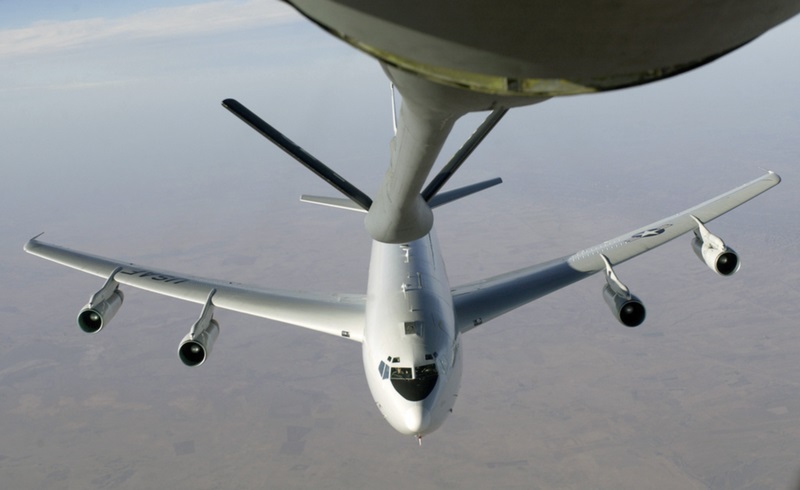
Communications capabilities were improved as well, including addition of a Link-16 datalink system, a superset of JTIDS, to improve communications with strike aircraft; an "Improved Data Modem (IDM)" for communications with Army air assets, particularly AH-64 Apache gunship helicopters; and receivers to allow Joint-STARS to pick up intelligence network broadcasts.
The 11th E-8C was the first "Block 20" aircraft, featuring two commercial Compaq (now HP) "Alpha" processors that replaced the five mil-standard processors fitted on the earlier "Block 10" E-8Cs. The two Alpha processors had substantially more total processing power than the five older processors they replaced, and were based on "open" architectures, making them easier to expand and modify. The Block 20 E-8C also featured new workstations, provided by Compaq; a new radar signal processor provided by General Dynamics; and a fiber-optic network for system interconnection on the aircraft. The earlier Block 10 E-8Cs were brought up to Block 20 specification.
The most ambitious upgrade planned for Joint-STARS was the "Radar Technology Insertion Program (RTIP)", which was to provide the platform with a much more capable radar system. However, RTIP went off in a number of confusing directions, a matter discussed below. There have also been considerations of updating the E-8C's battle-management system to reduce its operating crew to two or three, using artificial intelligence technology -- but the status of that effort is unclear.
* Ground systems were improved as well. The AN/TSQ-178 GSM was phased out in 1999, replaced by the more sophisticated AN/TSQ-179 "Joint-STARS Common Ground Station (CGS)". Like the GSM, the CGS was truck-mounted and highly mobile. CGS had secure direct radio and satellite data links to communicate with Joint-STARS, and could display and process Joint-STARS data for relay to field forces. CGS could obtain intelligence data from other assets, such as other crewed battlefield surveillance aircraft or drones. CGS could perform "data fusion" on multiple inputs to provide better intelligence output. CGS output was relayed to field units through a truck-mounted "Tactical Operations Center (TOC)". The Army obtained 96 CGS systems, while the Marine Corps obtained 3.
A simplified "man-portable" Joint-STARS terminal, the "Joint Services Work Station (JSWS)", was adopted by the USAF and the US Navy. The JSWS gave access to a subset of Joint-STARS data. The Army also obtained an improved "Distributed CGS" to allow uniform access from the level of the battlefield commander with a workstation, to that of a squad leader with a portable computer.
* In 2005, a contract was finally awarded to upgrade the E-8C's cockpit from its 1950s "steam room" configuration to a modern glass cockpit. Other upgrades included a secure network to allow operators to chat with operators and end users elsewhere, and a software upgrade called the "Affordable Moving Surface Target Engagement" system to allow a Joint-STARS to take control of a long-range guided weapon fitted with a datalink and use it to attack naval vessels.
There was also a painful effort to upgrade the aircraft's TF33 engines, which were not only are old and increasingly hard to maintain, but also had inadequate power for full-gross-weight flight operation. Upgrading to CFM turbofans, which would be the technically sexy solution, was regarded as too expensive, but a cheaper and effective fix was available: replacing the original 707 JT3D turbofans with JT8D-219 turbofans.
At first sight that might have seemed like a step backward, since the original JT8D was a less powerful contemporary of the JT3D. However, in the early 1980s Pratt & Whitney introduced the second-generation JT8D Series 200 engine, which was largely redesigned and was a perfectly modern engine for the 1980s. It was more powerful than the JT3D, as well as much cleaner, much quieter, and more fuel-efficient. A JT8D could be swapped with a JT3D with minimal aircraft modifications since the form-factor and interfaces are similar. Advocates of JT8D re-engining claimed the new engine fit would actually have lower operating costs than a CFM upgrade.
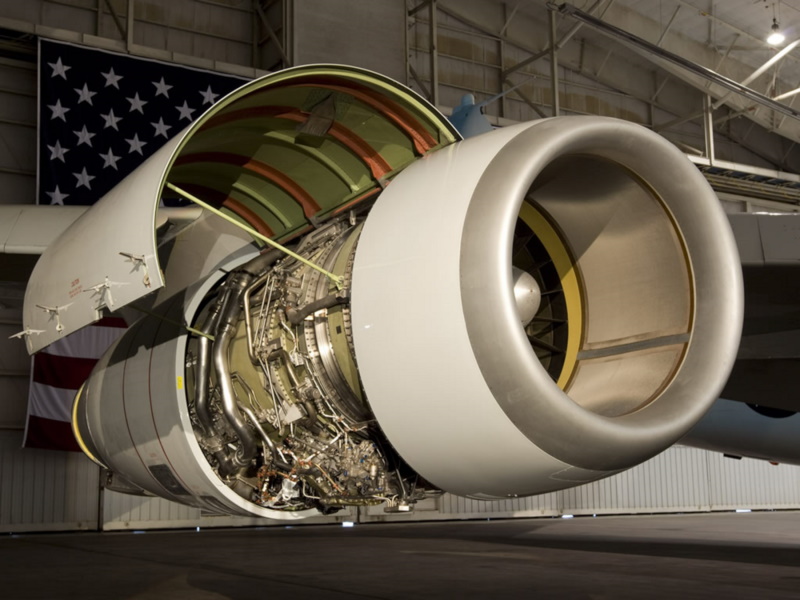
Pratt & Whitney formed a partnership with a San Antonio, Texas, based company named "Seven Q Seven" in the late 1990s to explore the possibilities for a JT8D upgrade for the various 707-based military platforms in service around the world. The partnership led to the flight of a 707 demonstrator with three JT3Ds and one JT8D in July 1999. The effort went quiet for a while, but was revived when the Air Force issued a requirement for re-engining their Joint-STARS aircraft. That led to the initial flight of a 707 demonstrator with four JT8D-219 turbofans on 9 August 2001. P&W / Seven Q Seven estimated that there was a market for re-engining up to 70 militarized 707s, such as USAF E-3s, with the JT8D, and were considering the idea of re-engining commercial 707s as well. Price of an upgrade was estimated at $20 million to $25 million USD. The exercise went up and down for about a decade -- and then disappeared.
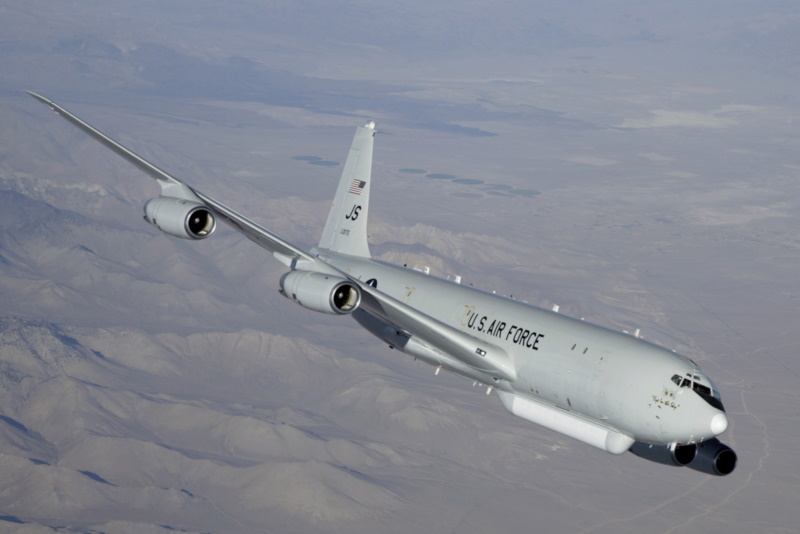
* The reason the re-engining effort fizzled out was because, after several years of vacillation, the E-8C was judged not to have a future. The story is complicated.
As mentioned previously, the military had been working on the RTIP upgrade, with the original intent to improve the capabilities of Joint-STARS. However, with surveillance being performed by business jets and drones, it seemed prudent to expand the scope of the program to "multi-platform" support, with the program's name changed appropriately to "MP-RTIP". A contract for the MP-RTIP system was awarded to Raytheon and Northrop Grumman in late 2000. Raytheon was to build the radar system itself, while Northrop Grumman handled systems integration, with the Northrop Grumman Global Hawk long-range drone targeted for initial implementation of MP-RTIP.
MP-RTIP was based on a next-generation X-band "active electronically scanned array (AESA)" system that could track low-flying, stealthy, fast-moving missiles hundreds of kilometers away. An AESA can be thought of as a radio-frequency (RF) "array processor", composed of a grid of interconnected "transmit-receive" modules, each with its own RF, processing, and control electronics. The modules can work with each other to perform a wide variety of tasks -- active radar sensing, passive electronic sensing, communications, and jamming -- in an interleaved or parallel fashion. One of the advantages of an AESA is that it lends itself to a scalable design, since the array can be sized to different platforms by fitting fewer or more modules as required, with capability proportional to size.
MP-RTIP ended up being fielded, as the "AN/ZPY-2", on the Block 40 Global Hawk -- but ironically, not on Joint-STARS, which got bogged down in fumblings over a replacement platform. The Air Force had considered a follow-on to Joint-STARS designated the "Wide Area Surveillance (WAS)" aircraft, but this scheme was gradually seen as too limited. What complicated the issue was the USAF's parallel effort to obtain a replacement for their current Boeing KC-135 aerial tanker fleet, with the Boeing 767 jetliner selected as the best option at the time, and in fact eventually selecting the 767 for the role. In any case, as long as the Air Force was planning on acquiring the 767 for the tanker role, it seemed sensible to acquire it for the surveillance role as well.
Initially, there was some push to actually merge the two roles to an extent, with the tankers capable of carrying a pallet of SIGINT, surveillance gear, or battlefield communications relay gear, with the pallets swapped out as required by the mission; but the "smart tanker" concept gradually faded into the background, while the idea of using the 767 as a surveillance platform, initially designated the "Multi-Sensor Command & Control Aircraft (MC2A)", remained in the foreground. The Lincoln Labs 707 testbed, configured as an experimental "MC2A-X" prototype of the production MC2A, performed its first flight on 18 April 2002. The machine was given the name "Paul Revere" to reflect its mission to provide warning of attack.
In the summer of 2003, the Air Force awarded a contract to Boeing for a testbed aircraft, based on the Boeing 767-400ER airliner. The production MC2A was to be designated the "E-10A". The original plan was to begin with the battlefield surveillance mission; then add an airborne early warning (AEW) capability to the E-10A, allowing it to replace the E-3 AWACS; and then add SIGINT capabilities, allowing it to replace the RC-135 Rivet Joint platform. Critics suggested that trying to have one aircraft do all three functions was flying in the face of the laws of physics, and the Air Force then considered separate "E-10B" AEW and "E-10C" SIGINT versions.
Although defense programs do tend to be moving targets during their early development, the E-10A MC2A ran into particularly troublesome political difficulties because Congress found the Air Force's story on the machine exasperatingly fuzzy and inconsistent. Members of Congress weren't the only ones baffled; AVIATION WEEK magazine summed up the exasperation in a short article titled "One Plane To Confuse Them All" -- no doubt the author was a Tolkien fan.
Other political difficulties were catching up with the program as well. It was about at this time that the program's linkage to the 767 tanker effort led to difficulties. The Air Force and Boeing came up with an unconventional funding scheme for the tankers based on a lease arrangement. The lease deal attracted some very negative attention from the US Congress, with critics claiming it amounted to a pay-off program for Boeing at taxpayers' expense. That was only the start of the tanker program's political troubles, with the Air Force painfully stumbling through repeated cycles of trying to get the program off the ground, only finally managing to get a contract awarded to Boeing for the 767-based "KC-46" in 2011.
The details of the nightmarish tanker procurement effort cannot be considered here. Enough to say that the E-10 MC2A effort was caught in the turbulence, and its shifting definition didn't inspire confidence in the project in Congress, particularly at a time when the US armed services were heavily committed in the Middle East and money was tight. The E-10 was cut from the Fiscal Year 2008 budget.
* In the wake of this fiasco, the fallback plan was to upgrade the Joint-STARS fleet. With funds tight Northrop Grumman forgot about MP-RTIP, instead envisioning enhancements to the AN/APY-7 radar system and other avionics, along with the addition of an MS-117 multispectral imager at the rear of the radar canoe fairing -- the imager had already been evaluated on a Joint-STARS -- and two AESA arrays in "cheek" positions on the side of the forward fuselage. The AESA arrays would be based on technology developed for the F-35 Joint Strike Fighter program, and would provide much of the capability of MP-RTIP at lower cost.
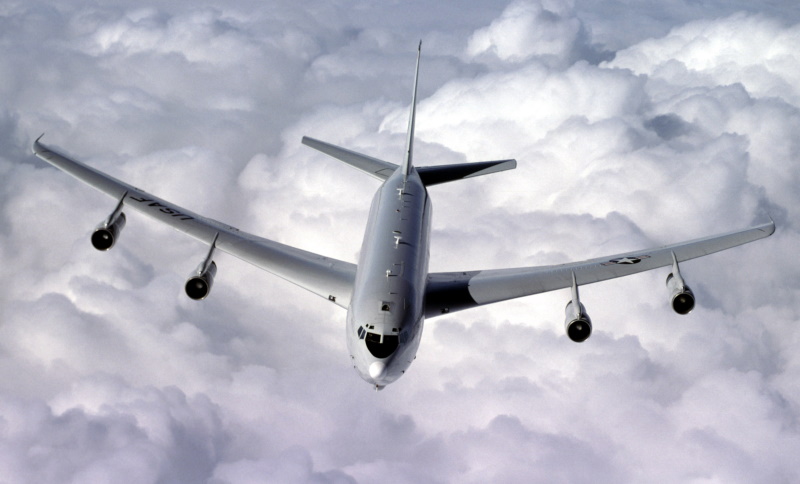
That ended up more or less a non-starter as well, since the Air Force finally decided to replace the fleet with the Global Hawk drone and with a smaller crewed platform. The simple reality is that system avionics have improved so much, becoming more compact and capable, that a smaller aircraft could do the job perfectly well. The replacement system would be much more automated and much cheaper to operate.
However, after several years of more fumbling around, the effort ran out of steam, with the armed services wondering if a JSTARS replacement was really the right answer, or the real solution would be a networked system involving crewed aircraft, drones, and even space-based assets. In any case, the Joint STARS fleet was retired, phase-out beginning in 2022, and last operational flight in 2023.
BACK_TO_TOP